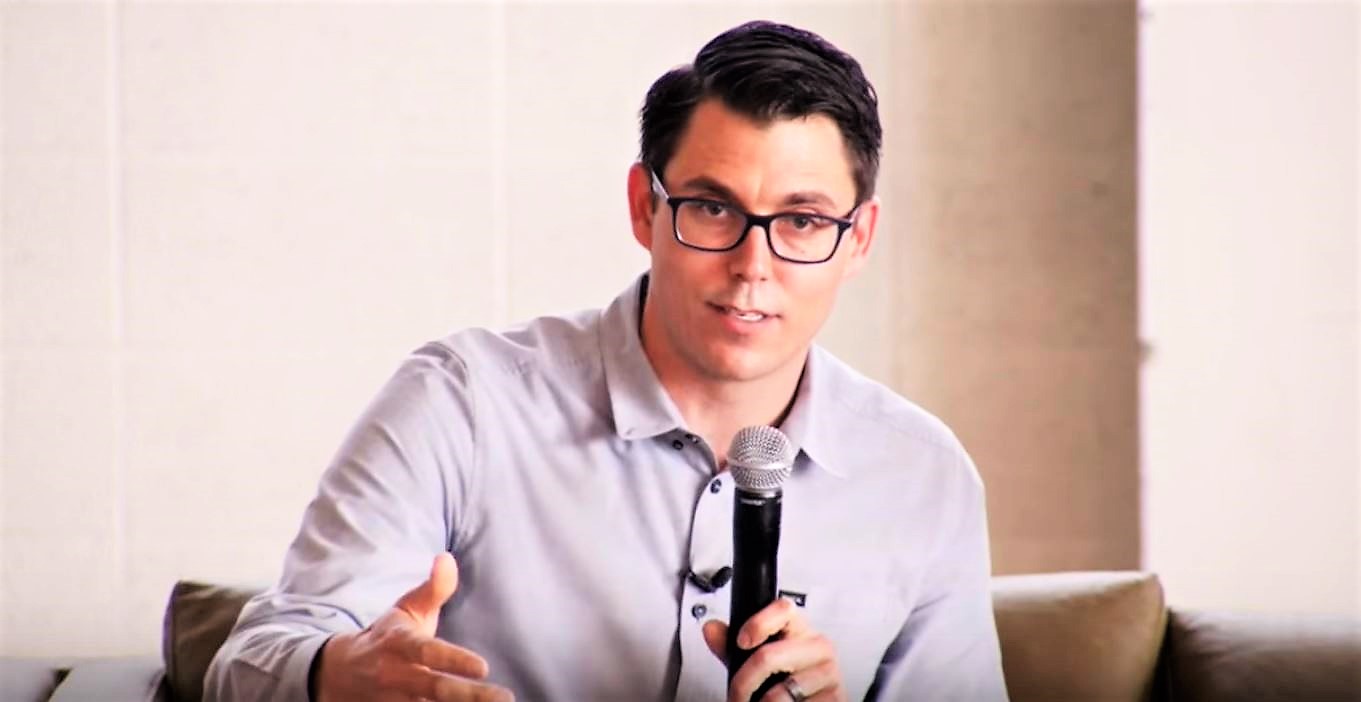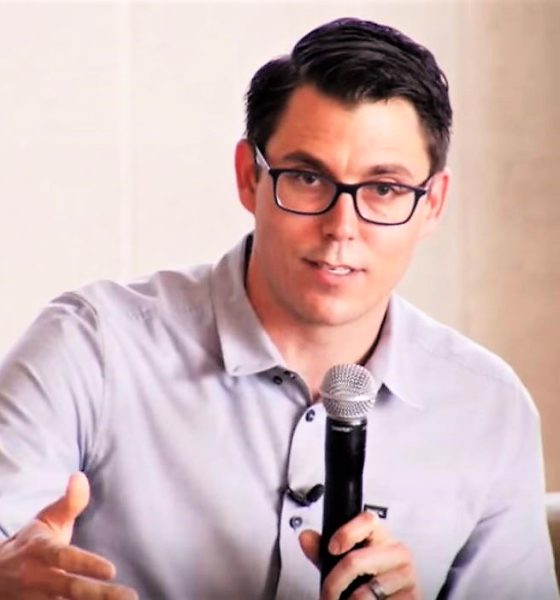

News
Rivian’s RJ Scaringe talks on-site farming plans for employees, battery storage solutions
Rivian CEO RJ Scaringe recently shared insights about the company’s psychology in a livestreamed conversation with professional rock climber Alex Honnold and Rich Roll, a long-time wellness advocate and endurance athlete. As Rivian develops the manufacturing capabilities necessary to build its all-electric R1T pickup truck and R1S SUV at market scale, serious consideration is going into how to harness their team’s energy into an industrial system that works for everyone involved.
“So, industrial systems you have very often are very much class-based system – the white collar workforce, the blue collar workforce – there’s a whole host of things that lead those two sides to often having friction. We see how unions have come in to sort of help try to make those two work a little bit better together. But, a big part of what we’re doing right now is actually mapping out and thinking about the psychology of our company and the psychology of this facility,” Scaringe detailed during the event.
One of the unique things Rivian has inherited during its growth into a full-fledged auto manufacturer is the work force from the 2.6 million square foot plant the company purchased from Mitsubishi. Scaringe described the human story of the facility as “remarkable”, citing how many of the people currently there were part of the original launch team that later had to shut the facility down.
“So, 1989-1990, there are people that are 21-22 years old, they launched the facility….25-30 years go by, they’re part of the team running it, building it, now have to shut this facility down,” Scaringe described. “When we bought the facility, we not only just got the hardware, the acreages of land…[Now] we’ve got a team of people that’s passionate about restarting the facility.”
The company hopes the motivation to restart the plant under a Rivian badge will carry over into a win-win for all involved.

“It’s really remarkable. I mean, I think we’ve got a gift to work with in terms of that level of energy and that passion to bring it back to life,” the CEO said. “As we think about how do we take this gift that we’ve been given in terms of a workforce that’s so motivated, and how do we challenge a lot of the conventions that have been built up in terms of industrial systems…we’re doing a lot of things in the facility to really take that energy and supercharge it, really harvest it.”
One of the ideas Rivian is working to benefit on-site employees utilizes the resources inherited from the plant itself. The acreage surrounding the actual facility isn’t entirely needed for production purposes, so the car maker is planning to partner with local universities for food production from ground to plate.
“We have 508 acres at the plant, a very small percent of which actually has the plant occupying it – most of it’s just grass. We’re gonna be turning a lot of that into an area to grow food. And we’re gonna run that in partnership with some of the local universities through their agriculture programs to grow food locally on our site…and then that food’s gonna be served in our facility with students that are learning from top chefs we’re bringing in to run the food services in our facility, and we’re gonna provide incredible food to our plant team regardless of what part of the plant you work in,” Scaringe revealed.
“[That way]…there’s true equity. Every employee is part of this mission of bringing this facility back up. And that positive energy that we’re establishing at the plant, we want it to be a benchmark for how industrial systems are run – the collaboration, the communication between groups, between our other facilities.”
The conversation with Rich Roll and Alex Honnold primarily involved another part of the company’s psychology – helping to accelerate widespread adoption of renewable energy. Rivian has partnered with the Honnold Foundation to use the electric truck maker’s “second-life” auto batteries for a micro-grid solar system in Adjuntas, Puerto Rico. Through this project and others in the future, older battery cells that are no longer efficient for electric vehicles are repurposed into stationary energy storage units.
Adjuntas was selected as their first project site due to the town’s need for energy assistance after struggling in the wake of Hurricane Maria in 2017. The Honnold Foundation and Rivian will be using 135 kWh battery packs from R1T and R1S development vehicles for that particular grid project; however, cells going into Rivian’s production vehicles have been purposefully designed to have a “second life” in energy storage. The move towards energy projects marks a huge step for Rivian, signaling its expansion beyond the manufacture of all-electric luxury adventure vehicles.
Rivian’s first vehicle deliveries to customers are still planned for the end of 2020. Scaringe said during the event that around 800 members of their preorder community, i.e., reservation holders, were in attendance at the event with Roll and Honnold, so a further manufacturing update was provided with that in mind.
“There’s a lot of stuff happening [at the plant]. We’re moving equipment, we’re putting new equipment in. We’ve got amazingly talented people working day and night to bring that facility up and start delivering cars as quickly as possible,” he promised.
Watch RJ Scaringe, Alex Honnold, and Rich Roll discuss the Honnold Foundation and Rivian’s facility details in the video below:

News
Tesla FSD fleet is nearing 7 billion total miles, including 2.5 billion city miles
As can be seen on Tesla’s official FSD webpage, vehicles equipped with the system have now navigated over 6.99 billion miles.

Tesla’s Full Self-Driving (Supervised) fleet is closing in on almost 7 billion total miles driven, as per data posted by the company on its official FSD webpage.
These figures hint at the massive scale of data fueling Tesla’s rapid FSD improvements, which have been quite notable as of late.
FSD mileage milestones
As can be seen on Tesla’s official FSD webpage, vehicles equipped with the system have now navigated over 6.99 billion miles. Tesla owner and avid FSD tester Whole Mars Catalog also shared a screenshot indicating that from the nearly 7 billion miles traveled by the FSD fleet, more than 2.5 billion miles were driven inside cities.
City miles are particularly valuable for complex urban scenarios like unprotected turns, pedestrian interactions, and traffic lights. This is also the difference-maker for FSD, as only complex solutions, such as Waymo’s self-driving taxis, operate similarly on inner-city streets. And even then, incidents such as the San Francisco blackouts have proven challenging for sensor-rich vehicles like Waymos.
Tesla’s data edge
Tesla has a number of advantages in the autonomous vehicle sector, one of which is the size of its fleet and the number of vehicles training FSD on real-world roads. Tesla’s nearly 7 billion FSD miles then allow the company to roll out updates that make its vehicles behave like they are being driven by experienced drivers, even if they are operating on their own.
So notable are Tesla’s improvements to FSD that NVIDIA Director of Robotics Jim Fan, after experiencing FSD v14, noted that the system is the first AI that passes what he described as a “Physical Turing Test.”
“Despite knowing exactly how robot learning works, I still find it magical watching the steering wheel turn by itself. First it feels surreal, next it becomes routine. Then, like the smartphone, taking it away actively hurts. This is how humanity gets rewired and glued to god-like technologies,” Fan wrote in a post on X.
News
Tesla starts showing how FSD will change lives in Europe
Local officials tested the system on narrow country roads and were impressed by FSD’s smooth, human-like driving, with some calling the service a game-changer for everyday life in areas that are far from urban centers.

Tesla has launched Europe’s first public shuttle service using Full Self-Driving (Supervised) in the rural Eifelkreis Bitburg-Prüm region of Germany, demonstrating how the technology can restore independence and mobility for people who struggle with limited transport options.
Local officials tested the system on narrow country roads and were impressed by FSD’s smooth, human-like driving, with some calling the service a game-changer for everyday life in areas that are far from urban centers.
Officials see real impact on rural residents
Arzfeld Mayor Johannes Kuhl and District Administrator Andreas Kruppert personally tested the Tesla shuttle service. This allowed them to see just how well FSD navigated winding lanes and rural roads confidently. Kruppert said, “Autonomous driving sounds like science fiction to many, but we simply see here that it works totally well in rural regions too.” Kuhl, for his part, also noted that FSD “feels like a very experienced driver.”
The pilot complements the area’s “Citizen Bus” program, which provides on-demand rides for elderly residents who can no longer drive themselves. Tesla Europe shared a video of a demonstration of the service, highlighting how FSD gives people their freedom back, even in places where public transport is not as prevalent.
What the Ministry for Economic Affairs and Transport says
Rhineland-Palatinate’s Minister Daniela Schmitt supported the project, praising the collaboration that made this “first of its kind in Europe” possible. As per the ministry, the rural rollout for the service shows FSD’s potential beyond major cities, and it delivers tangible benefits like grocery runs, doctor visits, and social connections for isolated residents.
“Reliable and flexible mobility is especially vital in rural areas. With the launch of a shuttle service using self-driving vehicles (FSD supervised) by Tesla in the Eifelkreis Bitburg-Prüm, an innovative pilot project is now getting underway that complements local community bus services. It is the first project of its kind in Europe.
“The result is a real gain for rural mobility: greater accessibility, more flexibility and tangible benefits for everyday life. A strong signal for innovation, cooperation and future-oriented mobility beyond urban centers,” the ministry wrote in a LinkedIn post.
News
Tesla China quietly posts Robotaxi-related job listing
Tesla China is currently seeking a Low Voltage Electrical Engineer to work on circuit board design for the company’s autonomous vehicles.

Tesla has posted a new job listing in Shanghai explicitly tied to its Robotaxi program, fueling speculation that the company is preparing to launch its dedicated autonomous ride-hailing service in China.
As noted in the listing, Tesla China is currently seeking a Low Voltage Electrical Engineer to work on circuit board design for the company’s autonomous vehicles.
Robotaxi-specific role
The listing, which was shared on social media platform X by industry watcher @tslaming, suggested that Tesla China is looking to fill the role urgently. The job listing itself specifically mentions that the person hired for the role will be working on the Low Voltage Hardware team, which would design the circuit boards that would serve as the nervous system of the Robotaxi.
Key tasks for the role, as indicated in the job listing, include collaboration with PCB layout, firmware, mechanical, program management, and validation teams, among other responsibilities. The role is based in Shanghai.
China Robotaxi launch
China represents a massive potential market for robotaxis, with its dense urban centers and supportive policies in select cities. Tesla has limited permission to roll out FSD in the country, though despite this, its vehicles have been hailed as among the best in the market when it comes to autonomous features. So far, at least, it appears that China supports Tesla’s FSD and Robotaxi rollout.
This was hinted at in November, when Tesla brought the Cybercab to the 8th China International Import Expo (CIIE) in Shanghai, marking the first time that the autonomous two-seater was brought to the Asia-Pacific region. The vehicle, despite not having a release date in China, received a significant amount of interest among the event’s attendees.








